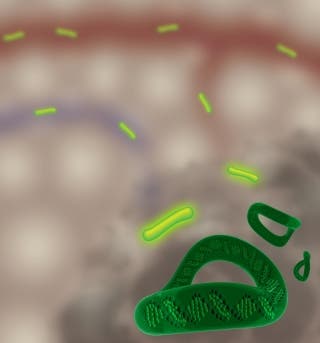Stanford scientists proved that it’s possible use DNA minirings that code the production of a specific protein that can’t be found in healthy cells to diagnose any form of cancer. The mini-rings were injected in the bloodstream of mice and allowed for accurate diagnosis up to two days from the injection. In authors envision using the same solution to diagnose any cancer in humans, while also relaying how large is the extent of the tumour. Moreover, they hope they can achieve this with an orally administered pill, instead of an intravenous injection, thus making it the least invasive form of cancer diagnosis. The only pain you’ll experience is when doctors will prick a needle in your finger to get a drop of blood. Take that, biopsy!
Looking for cancer in all the right places

Researchers inserted tiny DNA minicircles into the genes of mice, which caused cancer cells to emit a substance that could be detected from a blood sample. Credit; Jim Strommer
Cancer biomarkers – substances that flag the presence of a particular kind of tumour – aren’t new in medicine. We’ve heard about quite effective efforts where prostate cancer, for instance, was detected judging from the high blood levels of a prostate-specific antigen. Similar biomarkers were identified for ovarian and colorectal cancer. Each of these biomarkers, however, is unique to its cancerous form which means you’d need to take a separate test for each cancer. Also, some of these proteins surface in a healthy cells as well leading to false positive diagnosis.
Sanjiv “Sam” Gambhir, professor and chair of radiology and director of the Canary Center at Stanford for Cancer Early Detection, believes the progress his team made with DNA mini-circles will solve most of the challenges faced by cancer biomarker detection techniques.
The Stanford researchers’ DNA minicircle is a tiny, artificial, single-stranded DNA ring about 4,000 nucleotides in circumference. Its function is to code for the production of a protein called secreted embryonic alkaline phosphatase. SEAP is naturally produced in human embryos as they form and develop, but it’s not present in adults. The minicircles, which contained a single gene coding for SEAP, were mixed with a chemical agent to facilitate their uptake by both healthy and cancerous cells alike.
The real ingenious part was adding a genetic promoter in front of the gene that codes SEAP production. In genetics, promoters are DNA sequences that instead of making proteins are involved in regulating them. Like a switch, promoters will tell the gene its linked to when and if it needs to activate its function, or how many proteins to make. This particular promoter normally regulates a gene called survivin that, in adults, is only “on” in cancer cells. This way, the SEAP proteins were made only in organisms were cancer is present. With this in mind, it’s only a matter of a taking a blood sample and looking for any signs of SEAP proteins.
In experiments, scientists injected cells from human melanoma cell lines into immune-compromised laboratory mice. Because their immune system was jacked, antibodies didn’t attack the cancer cells and were free to develop into tumours throughout the body – the lugs were particularly affected. Other mice of the same strain were given otherwise-identical injections that didn’t contain the cancer cells; they didn’t develop tumors. According to the Stanford press release:
About two weeks later, the animals’ blood was checked to make sure their baseline levels of SEAP were zero. Then the investigators injected the minicircles intravenously into the animals’ tail veins and measured SEAP levels in the mice’s blood one, three, seven, 11 and 14 days later. Within 48 hours, SEAP was present in the blood of mice with tumors, but not in that of the tumor-free animals. That signal began declining in strength as early as 72 hours post-injection, fading to insignificance within the next two weeks or so. Its maximum strength varied with the total tumor volume in a mouse’s lungs, suggesting that the test may be sensitive not only to the presence of cancer but also to its extent.
DNA mini-circles boost several advantages over other similar methods, like defanged viruses or specially engineered bacteria. The mini-circles do not replicate, nor do they elicit an immune response.
“We want to translate this strategy into humans, so we’ve set it up in a way that’s most likely to be effective, safe and convenient,” said Gambhir, who is also the Virginia and D.K. Ludwig Professor for Clinical Investigation in Cancer Research. Although the minicircles were injected intravenously to the mice in this study, it should eventually prove possible to deliver them orally via a pill, he said. “We haven’t got it down to a pill yet, but the oral delivery part of this is likely a solvable problem — only a few years off, not five or 10 years off.”
Findings appeared in the journal Proceedings of the National Academy of Sciences.









